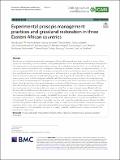| dc.description.abstract | Woody species have been introduced in many parts of the world to provide economic benefits, but some of those
species are now among the worst invaders, causing widespread economic and environmental damage. Management
of woody species to restore original ecosystem services, such as biodiverse grassland that can provide fodder and
sequester carbon, are needed to limit the impacts of alien species. However, the best management methods, i.e., the
most economically efficient and effective way to remove trees and the most effective way to restore or rehabilitate
the cleared land, are not developed for many species. In Eastern Africa, prosopis (Prosopis julifora) has invaded large
areas of savanna and grassland, thereby affecting, among other things, fodder and water for livestock, access to dry
season grazing lands and ultimately pastoral livelihoods. We tested three prosopis treatments (manual uprooting
and cut stump and basal bark herbicide application) in combination with three incremental restoration interventions
(divots, divots + mulching, divots + mulching + grass seed sowing). The three-year study was replicated in Ethiopia
(Afar National Regional State), Kenya (Baringo county) and Tanzania (Moshi district). Prosopis survival and vegeta-
tion development, both diversity and biomass, were recorded. The prosopis treatments were all highly effective
(between 85 and 100% tree mortality in almost all cases), but the two treatments that involved the complete removal
of the aboveground biomass (manual and cut stump) yielded a more productive and more diverse vegetation than
the treatment that killed the trees standing (basal bark). Compared to the effect of prosopis removal, the effect of
restoration interventions on vegetation composition was small, indicating that most species re-established from the
soil seed bank. The results show that it is possible to restore land previously invaded by prosopis. Despite the differ-
ent rates of vegetation establishment and variation in species composition, the restoration interventions resulted in
vegetation that in some cases contained a substantial fraction of perennial grasses. The method chosen to control
prosopis depends on the availability of resources, including herbicides, and the need to remove rootstocks if the
intention is to plant crops. | en_US |

